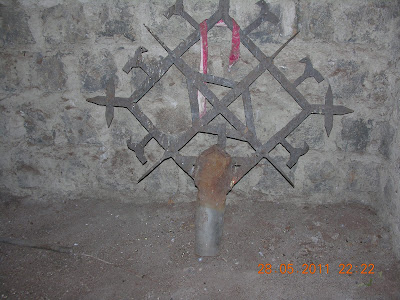After a refreshing visit to Tana lake and the night
strolling in the city of Bahir Dar we departed for the city of forts and
castles “Gondar”. The road journey which
would have ideally taken 4-5 hours was completed in 7 hours, reason the
picturesque country side, sighting of exotic birds and the wonderful weather,
which made us stop every now and then to take pictures or simply enjoy the
scenery and the cool breeze.
Our driver was surprised at the enthusiasm we
showed in taking the pictures of the rocks, houses under construction and the
birds, because for them all these were part and parcel of daily life.
The rock in the shape of palm reminded me of the symbol
of a political party in India. Road winding through the hills and valley gave
the awe inspiring view.
Villagers make their houses with the locally available
raw material which are of natural origin. Very few houses are made with
stones/bricks. Eucalyptus tree trunks are used to make the basic structure of
the house and the rice/ wheat straws along with the mud is used to make the
walls. Thawed roof with opening at the top on which either old utensil or the big
dried gourd’s shell with a hole is placed for the smoke to go out. The some what rich in village make tin roof and richer than them make whole house of tin a big status symbol.
Cooking is done mainly by firewood or coal as
availability of gas is very scarce and expensive. Electricity has yet to reach
to most of the villages, so is piped water supply.
Large birds were roaming in the farms as they are neither
killed (religious belief) nor disturbed. Stopping by each and every village and
interacting through our driver Daniel we reached Gondar by noon.
Weather was excellent as it in most part of the Ethiopia.
There are excellent hotel in Gondar two of them at the hill top giving birds
eye view of Gondar. We stayed in the hotel which was in the heat of city.
Gondar is in north of Tana Lake. Germans and Dutch have
set their wineries and breweries. It is the courteous nature of the staff and
the hospitality of every hotel in Ethiopia that was so genuine that one feels
so welcome and happy. We had a quick lunch of club sandwiches and coffee and
proceeded for our tour of the city.
Apart from many castles and forts it has the royal
enclosure called Fasil Gehbbi, because of this it is also called Camelot of
Africa. The water storage and supply system of those days in the forts and castels shows the foresightness of the Emperor fasilides.
Gondar as capital was established by emperor Fasilides as the capital first
of Ethiopia. The city served as the agricultural and market center till it was
burned and destroyed by invaders.
Forts and castles of Gondar are world heritage and thus
maintained jointly by Govt. of Ethiopia and World Heritage Center. Forts
ranging from year 1600 onwards are maintained very nicely and give the insight
to the rule of Fasilides, Iyasu, Yohhanes, and their descendants.
Ravaged by
invaders ruins are left.
In twentieth century Italians used the palaces and
forts which were in good condition as their garrison and the air strikes during
war converted those places also to relics and ruins.
How much truth is there I do not know but our guide told that Empress's jewellery and Emperor's was found by invadors and was plundered. People yet think that the walls of ruins have gold hidden in it.
How much truth is there I do not know but our guide told that Empress's jewellery and Emperor's was found by invadors and was plundered. People yet think that the walls of ruins have gold hidden in it.
These ruins make a
picturesque sight amongst the green ground.Graet Ethiopian lions were kept by Emperors. Till late one last was left but now only emoty cage is there to be seen. In Hindi there is a saying " Yeh Khandhar saboot Hai, Ki Kila kabhi aabaad tha" meaning tese ruins are proof that the place was bustling with life and prosperity, how true it fits the description of this place.
Fasilides Bath and the Qustuam complex was built by Empress
Mentewab in 18th century. This place is home to annual ceremony for
baptism and holy bathing. The trees with huge green canopy and wide spread roots provide shelter to visitors and look very picturesque.
Apart from this Ras Mikael Sehul’s palace and Debre
Berhan Selassie Church of 18th century are worth the visit.
The church was closed when we visited. We were too
engrossed in going from one fort to other and taking photo.
Gondar is sleepy town at night. It is quite safe to go
around till on does not venture into small ally and by lanes.
We had a long day ahead as we were going back to Addis in
between visiting my dream river Blue Nile and water fall of Nile.





















































































